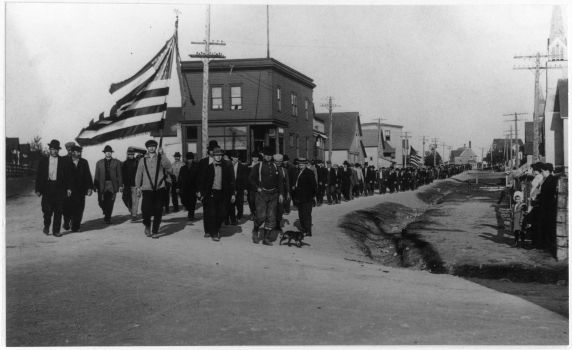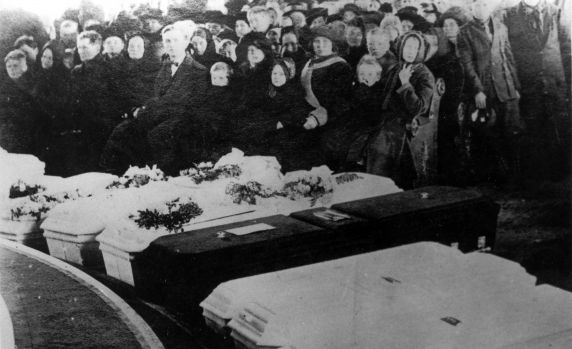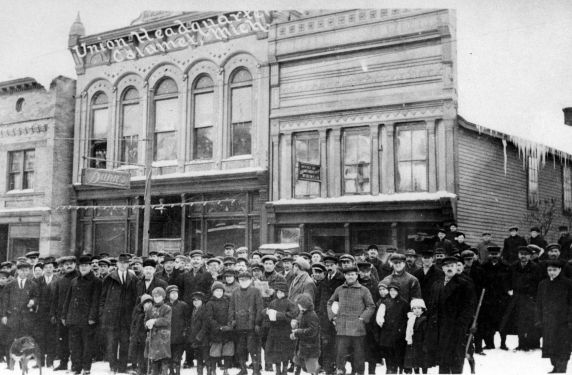Subject Focus: The 1913-1914 Copper Country Strike and the Italian Hall Disaster
December 24th, 2013 marks the 100th anniversary of one of the great tragedies of the early twentieth-century: the Italian Hall disaster of the 1913-1914 Copper Country Strike.
At the time, Michigan's Copper Country, an area of that includes all or parts of Keweenaw, Houghton, Baraga and Ontonagon counties in the west of the Upper Peninsula, held one of the richest deposits of copper in the world. Approximately 15,000 men worked the mines for little monetary compensation in conditions that could be considered deplorable in shifts that could stretch 10-12 hours. On July 23, 1913, approximately 9,000 copper miners of the Keweenaw region walked off the job. Led in their hopes by the Western Federation of Miners (WFM), the men demanded 8-hour workdays, better wages, improvements in mine-safety conditions, and the recognition of the union by the mines’ management. Many of the mining companies did not even bother to reply.
Though mines were completely shut down for a time, the companies’ administrations remained unmoved, unwilling to negotiate with the union. By August the mines had mostly reopened, though at a limited capacity, populated with scab workers imported from abroad and men who hadn’t the stomach for unemployment. Strikers’ parades were held early each morning in lieu of pickets as both morale boosters and shows of strength. They were timed so that the scab workers would have to pass through the taunting demonstrators. More often than not, these marches were led by the charismatic “Big Annie” Clemenc, the wife of a miner and president of the local Women's Auxiliary No. 15 of the Western Federation of Miners. Brandishing her oversized American flag, Clemenc was well known for her fearless nature and was arrested several times as a result of her persistent efforts to talk, or otherwise motivate, men out of returning to the mines. She became the national face of the strike in the press.

In the early days of organized labor, strikes could be dangerous affairs and violence was not unusual. Even by these standards, the statistics of Copper Country Strike of 1913-1914 are shocking. Clashes between strikers and company men were immediate, and, at the request of Houghton County Sheriff James Cruse, Governor Ferris sent the entire Michigan National Guard to keep the peace. For their part, the mines brought in detectives from the Waddell - Mahon agency of New York, a firm of well-known strikebreakers who would serve as "security guards" to protect company property and scab workers against retribution from the miners. The results of the strikebreakers’ presence were predictable. Clashes escalated in areas held by “Waddell men.” Vigilantism in the form of the “Citizen’s Alliance” escalated the violence against striking miners once the National Guard returned below the Straits. All told, countless participants and bystanders were injured, including Fourteen-year-old Margaret Fazekas, who was shot in the back of the head by Houghton County deputy sheriffs on Labor Day. Notably, Charles Moyer, the president of the WFM, was beaten, shot and forcibly placed on a Chicago-bound train with notice that he would be hanged if he returned to Copper Country. 78 people lost their lives during the strike, including two miners who were shot by sheriff deputies and three scab workers who were gunned down in their residence in the middle of the night.
The majority of the strike-related casualties occurred at what would come to be known as the Italian Hall disaster. On Christmas Eve, 1913, the Women's Auxiliary held a holiday party for the striking miners and their families at the Italian Hall on Second Street in Calumet. Hundreds of people attended the event on the second floor of the building, happily celebrating the end of what had been a particularly difficult year. Around 4:40 p.m., after the children had visited with Santa and received gifts donated by local businesses and union members throughout the country, a man entered the hall and shouted “Fire! Fire!” Unaware that there were other exits, a crowd headed for the narrow main stairwell. 73 people were crushed to death in the resulting panic. 59 of the victims were children.
The mass funeral for the victims on December 28th drew a crowd of over 20,000 mourners from all reaches of the Upper Peninsula. The funeral procession stretched two miles out of Calumet to Lakeview Cemetery, where the dead, now identified as “martyrs” by the WFM, were buried in large trenches. Despite the work of an inquest set up to look into the events of Christmas Eve, the identity of the person who caused the panic was never determined, nor was any evidence that there was a fire ever found.

In the face of such great loss, with financial support from the WFM cut off and with no clear end in sight, the strike concluded, unresolved, on April 13, 1914, nine months after it had begun. Miners were allowed back to work once they turned in their union cards. Though the strike was lost, many of the mining companies instated an 8-hour workday and some workers enjoyed a wage increase. Not all strikers enjoyed these benefits -- many miners, disheartened by the strike or blackballed for their organizing efforts, never returned underground. The Western Federation of Miners abandoned the region and returned its focus towards organizing the western states. The union would eventually make a comeback in Copper Country 25 years later under its successor organization The International Union of Mine, Mill, and Smelter Workers (IUMMSW-CIO).
The Reuther Library has a number of resources related to the 1913-1914 Copper Country Strike. The Western Federation of Miners: Calumet-Hecla Strike Records is a small collection with large research interest, composed of correspondence between attorneys representing miners in the strike in Michigan’s copper country. For contemporary views on the strike, The Western Federation of Miners “Miner’s Bulletin,” published between August 14, 1913-April 14, 1914, is an indispensable resource and available for viewing on microfilm. The Arthur W. Calhoun Papers contains clipping files from the strike and additional information on “Big Annie” Clemenc, is found within the Ann Shafer Papers. A particularly rich resource to consider is an interview with John Hill collected by the Folklore Archives. In the interview, Hill recounts his memories of life in Michigan’s Upper Peninsula during the 1913-1914 Copper Country Strike including: the Italian Hall disaster and its aftermath, the effect of the strike on migration out of the region, living conditions in Calumet during the strike, the wages of miners, the economic fate of the Calumet & Hecla Mining Company, mining accidents, organizing activities of the Western Federation of Miners, violence during the strike and scab workers. Those searching for a visual history of the 1913-1914 Copper Country Strike may find the images within the Strikes! Image Gallery of interest. Finally, many wonderful resources can be found throughout the web. Michigan Technical University has a large number of materials available online, as well as an excellent web exhibit. The Michigan Labor History Society has also been busy commemorating the event this past year. For more first-hand accounts of the Italian Hall Disaster, please look at their Spring/Summer 2013 newsletter.
- eclemens's blog
- Login to post comments
- Printer-friendly version


 Reddit
Reddit Facebook
Facebook LinkedIn
LinkedIn